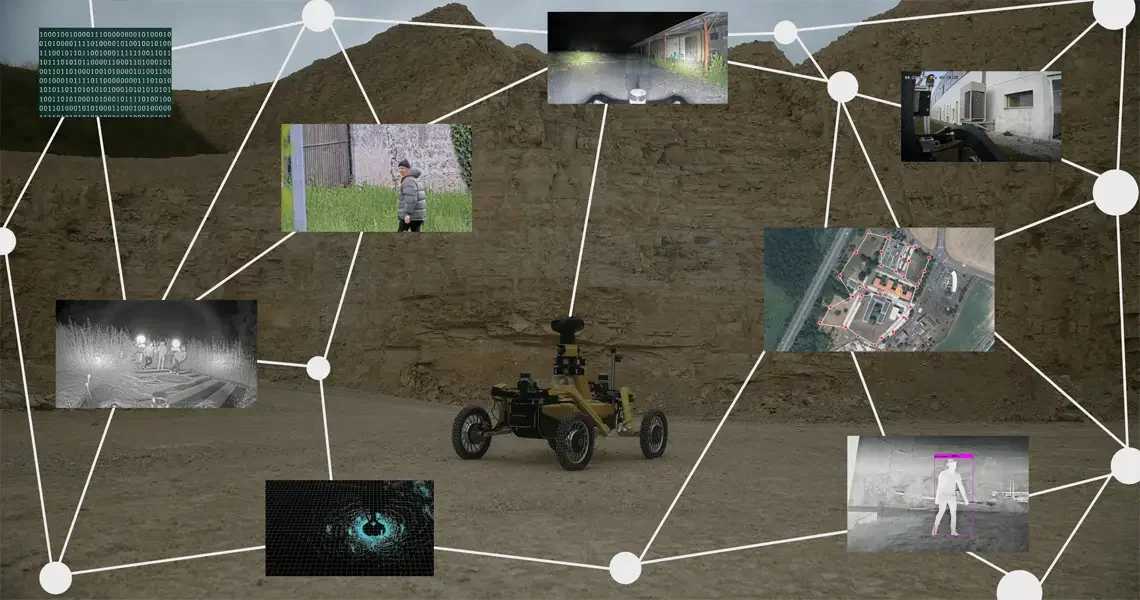By Anna Larrouy and Renato Cudicio
Autonomous robots like THALAMUS are designed to evolve in a variety of environments and perform tasks without direct human assistance. Beyond the advanced capabilities of their on-board artificial intelligence, their autonomy also depends on an invisible and essential factor: connectivity. To effectively carry out their surveillance mission, these robots need to be able to communicate continuously, in real time and without interruption with the central monitoring station, even when they’re on the move.
However, traditional networks (Wi-Fi, LTE, 5G) quickly reach their limits: dead zones, latency caused by network weakness or overload, or single points of failure (faulty router, damaged cable, etc.). In the context of mobile surveillance or intervention at remote sites, this can quickly become an obstacle. This is where Mesh technology comes into its own as a robust and suitable alternative.
What is a mesh network?
A mesh network is based on a decentralized architecture: each device on the network, called a node, can send, receive and relay data. No single center, no dependence on a single point of entry. The network becomes self-organizing and self-healing.
Imagine a group of hikers equipped with walkie-talkies: each member can transmit a message to another, or pass it on to a third if the targeted person is out of range. The result: the information always finds a way through, even if one of the members has lost his or her signal.
In a Mesh network, it’s the same thing. No single center, no dependence on a single point of entry. The network becomes dynamic. Data can take several paths to reach its destination, and if one path is blocked or saturated, another is used.
This makes the system:
- Reliable: no sudden interruptions
- Flexible: adapts to changing terrain or movement
- Resilient: the network continues to operate even if a node falls down
- Autonomous: no need for human intervention to reroute data
Data security at the heart of the system
The THALAMUS robot is naturally called upon to reinforce the surveillance of sensitive sites and large industrial infrastructures. As such, security managers who choose THALAMUS to secure certain perimeters pay particular attention to the protection of data transmitted by the robot. Of course, all the robot’s communications benefit from military-grade encryption. However, even though the robot uses LTE networks, its encrypted data transits via national telecoms infrastructures.
Installing a Mesh network on a site creates a completely closed bubble with its own encryption system. In this way, no data leaves the local network, inaccessible directly from the Internet.
Rajant Kinetic Mesh®
For the THALAMUS, Glocal Robotics chose to draw on the expertise of our partner Rajant, the dynamic Mesh specialist whose founders were motivated by the shortcomings of traditional wireless networks during the September 11, 2001 attacks, when first responder communications were severely disrupted.
Their technology is based on two elements:
- BreadCrumb, compact radio boxes that can be installed on any equipment: nodes.
- InstaMesh software, which automatically selects the best path and frequency to circulate data in real time.
Each node can communicate with several others simultaneously, reinforcing the stability of the network as more elements are added, unlike traditional mesh networks. The result is a network that constantly adapts to terrain and movement, while remaining compatible with existing Wi-Fi or Ethernet equipment.
Their technology is already in use in demanding environments: mines, ports, industrial sites and robots.
This Mesh infrastructure enables THALAMUS to:
- move freely without losing its connection
- transmit critical data (video, location and alerts) in real time
- automatically reconfigure the network to maintain the link in the event of a node failure
- receive and transmit communications protected by advanced encryption and packet authentication
Real-life use cases
Experience shows that the sites where THALAMUS works are generally far from major urban centers, and are therefore faced with weak, or sometimes even total absence of, 4G or 5G coverage. Mesh technology enhances the reliability and continuity of communications for THALAMUS. It enables them to operate in complex or poorly-covered environments, without compromising the reliability of critical data transmission.

